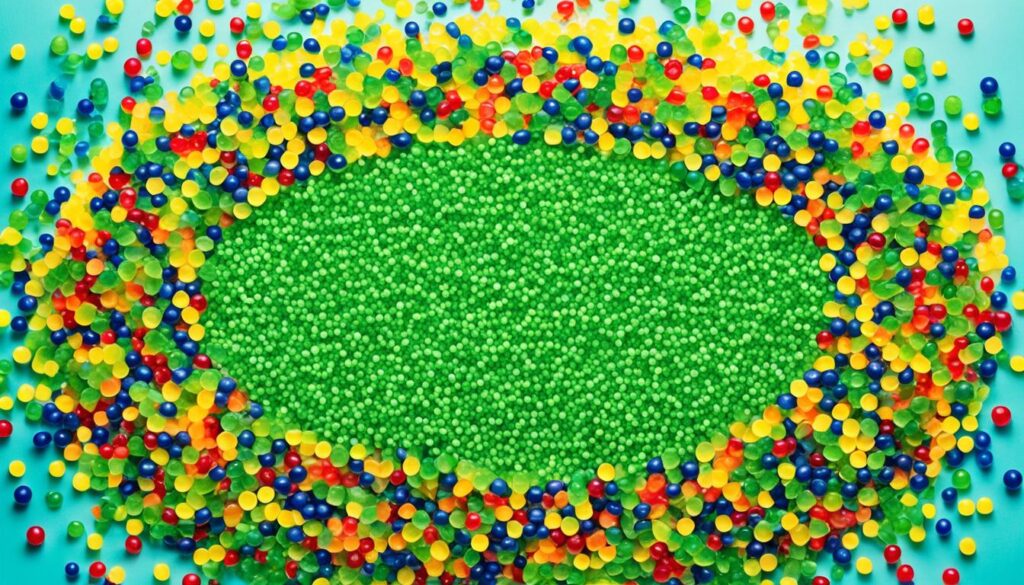Are Orbeez Biodegradable? Environmental Impact

Orbeez, or water beads, are tiny, squishy, and colorful. They expand in water, creating a fun experience. However, studies show potential environmental risks from Orbeez.
Their production uses fossil-based components. They also pose serious threats to wildlife. These factors raise concerns about Orbeez’s environmental impact.
Understanding Orbeez’s implications requires examining their full lifecycle. We’ll explore recent research, expert views, and data. This will reveal the true environmental cost of Orbeez.
Key Takeaways
- Orbeez are made from a synthetic polymer called sodium polyacrylate, which does not readily decompose in the environment.
- Orbeez do not meet the criteria for being biodegradable or compostable due to their synthetic composition.
- Improper disposal of Orbeez can lead to clogging and blockages in plumbing systems, and they can persist in natural water bodies.
- Ingestion of non-biodegradable Orbeez can cause digestive issues and health problems for wildlife.
- Reusing and properly disposing of Orbeez can significantly reduce their environmental impact.
Introduction to Orbeez
Orbeez are fascinating water-absorbing beads that have captured global attention. These tiny pellets transform into squishy, colorful spheres when soaked in water. Their magic comes from superabsorbent polymers, usually sodium polyacrylate.
What are Orbeez?
Orbeez were first created to help soil retain moisture for plants. Their unique properties have since found many uses in consumer products. These beads can absorb and hold large amounts of liquid compared to their size.
The Rise in Popularity of Orbeez
Orbeez have gained fame due to their pleasant feel and creative potential. They serve as stress-relief tools and sensory play items for child development. However, their popularity has raised concerns about their environmental impact.
Orbeez take hundreds of years to fully break down without help. They’re made of polyacrylate polymer, which degrades very slowly. Studies show only 0.12%-0.24% degradation every 6 months.
Based on these rates, the half-life of Orbeez ranges from 208 to 416 years. This means they persist in the environment for a very long time.
Understanding the Composition of Orbeez
Orbeez are colorful, squishy playthings made of sodium polyacrylate. This superabsorbent polymer can absorb hundreds of times its weight in water. It turns a practical material into a fun sensory experience.
The Maya Group introduced Orbeez in 2010. They changed how we use sodium polyacrylate. This synthetic polymer contains acrylic acid, sodium hydroxide, and coloring pigments.
Sodium Polyacrylate: The Primary Ingredient
Sodium polyacrylate is the main component in Orbeez. These gel-like beads take years to break down naturally. Sunlight, microorganisms, and environmental conditions affect their decomposition.
Orbeez aren’t compostable due to their long degradation time. However, they can be repurposed for gardening to retain soil moisture. Take proper precautions to avoid environmental hazards.
Store Orbeez in an airtight container with water in a cool, dry place. This keeps them vibrant and plump. Remember, Orbeez aren’t safe to eat. Keep them away from pets and children.
The Orbeez industry is working on making them more biodegradable and sustainable. They aim to reduce the environmental impact of these gel-based toys. This shows efforts to balance innovation with environmental responsibility.
Environmental Concerns Surrounding Orbeez
Potential Impact on Ecosystems
Orbeez pose a significant threat to the environment. These tiny beads can last for years, endangering wildlife and aquatic ecosystems. Animals might eat Orbeez, causing blockages or health problems that harm species populations.
Orbeez as a Source of Microplastics
Some water bead products release acrylamide, a potentially cancer-causing substance. This chemical can seep into water bodies, posing risks to the environment. Orbeez in natural waters may break down into microplastics over time.
These tiny plastic particles are hard to remove from the environment. Aquatic organisms can ingest them, potentially harming wildlife and disrupting ecosystems. This introduces microplastics into the food chain, causing widespread damage.
| Issue | Impact |
|---|---|
| Acrylamide emission | Potential carcinogenic effects, seeping into ground and water bodies |
| Microplastic pollution | Ingestion by aquatic life, entry into the food chain, ecosystem disruption |
| Intestinal blockage in wildlife | Threats to animal health and population numbers |
These issues highlight the need for better product design and disposal methods. Increased consumer awareness is crucial to protect ecosystems and wildlife. Responsible use and disposal of Orbeez can help minimize their environmental impact.
Are Orbeez Biodegradable?
Orbeez’s environmental impact raises questions about their biodegradability. The answer isn’t simple, but it’s important to understand.
Orbeez can be safely thrown away with household trash. However, their decomposition in landfills is incredibly slow.
A study by Environmental Science and Pollution Research International (2014) revealed surprising results. The main ingredient, sodium acrylate, decays at just 0.12% to 0.24% every 6 months.
Orbeez could take between 208 to 416 years to decompose by half. This shows they aren’t truly biodegradable compared to other materials.
“Orbeez are not truly biodegradable, as the decomposition process is extremely slow compared to other materials.”
Orbeez, or biodegradable water beads, degrade slowly due to their composition. They’re made of synthetic polymers designed to absorb and retain water.

The industry is working to improve biodegradability and promote sustainability of Orbeez. Consumers can help by disposing of them responsibly.
Consider exploring eco-friendly alternatives to Orbeez when possible. Every small action can make a difference for our environment.
The Slow Degradation Process of Orbeez
Orbeez, the popular water-absorbing polymer beads, aren’t as eco-friendly as they seem. Their main ingredient, sodium polyacrylate, breaks down very slowly. Studies show Orbeez can take 208 to 416 years to decay by half.
Landfills, where many Orbeez end up, don’t help them break down faster. This is why experts often consider Orbeez non-biodegradable. They can stick around for centuries without fully decomposing.
The orbeez decomposition rate and orbeez degradation timeline raise concerns about their environmental impact. Given how long do orbeez take to break down, we should consider eco-friendly alternatives. Responsible disposal methods can help reduce their long-lasting effects on our planet.
| Material | Decomposition Rate |
|---|---|
| Orbeez (Sodium Polyacrylate) | 208 to 416 years to decay by half |
| Paper | 2 to 6 weeks |
| Plastic Bags | 10 to 20 years |
| Glass Bottles | 1 million years |
“Orbeez are not biodegradable in the traditional sense. They do not decompose and can last for a long time without breaking down.”
Orbeez and Wildlife
Orbeez can harm wildlife if not used responsibly. Animals may mistake these small, water-absorbent beads for food. When carelessly discarded, Orbeez can end up in natural habitats, endangering local fauna.
Ingestion Risks for Animals
Orbeez are made from sodium polyacrylate, which swells when exposed to water. If animals swallow these beads, they can cause life-threatening internal blockages. Pets like dogs and cats are especially at risk due to their curious nature.
Aquatic life faces similar dangers from Orbeez. Fish might mistake the beads for food, leading to gill damage. Orbeez in waterways can disrupt ecosystems and harm biodiversity.
To protect animals, proper disposal of Orbeez is crucial. Keep them away from wildlife-accessible areas. Clean up spills quickly and dispose of Orbeez correctly.
| Animal | Ingestion Risks | Potential Health Impacts |
|---|---|---|
| Pets (dogs, cats, small mammals) | Curious nature, may mistake Orbeez for food | Intestinal blockages, life-threatening health issues |
| Aquatic Life (fish, marine animals) | May mistake Orbeez for food, accumulation in waterways | Gill damage, digestive tract blockages, disruption of ecosystems |
| Birds | May mistake dried Orbeez for seeds | Ingestion and potential internal blockages |
Using Orbeez responsibly helps protect wildlife and the environment. By understanding their impact on ecosystems, we can safeguard biodiversity. Proper handling of Orbeez contributes to the health of our natural world.
Responsible Disposal of Orbeez
Proper Orbeez disposal is vital to reduce their environmental impact. Flushing or washing them down drains can clog plumbing systems. Instead, throw Orbeez in the regular trash for landfill disposal.
Landfills aren’t ideal, but they’re currently the best way to handle Orbeez waste. Orbeez are made of sodium polyacrylate, a superabsorbent polymer. They can grow dramatically in size by absorbing water.
This property can cause expensive plumbing problems if Orbeez enter water systems. To avoid these issues, follow proper disposal methods.
Here are guidelines for safe Orbeez disposal:
- Avoid flushing Orbeez down the toilet or washing them down the drain, as they can persist in the environment for a long time and potentially disrupt ecosystems.
- Dispose of Orbeez in the regular trash, where they will end up in landfills.
- Consider alternative methods of disposal, such as using them in garden plants or for science experiments, to promote reuse and environmental consciousness.
By following these practices, you’ll help reduce Orbeez’s environmental impact. Your actions can contribute to a more sustainable future.
“Proper disposal of Orbeez is crucial to minimize their environmental impact and prevent costly plumbing issues.”
Promoting Reuse and Environmental Consciousness
Environmental concerns about Orbeez have sparked efforts to promote reuse and minimize waste. Reusing Orbeez helps reduce demand for new production and limits waste generation. After use, Orbeez can be dried and stored for future activities.
This practice reduces waste and fosters environmental consciousness. It teaches people to maximize resources, even if they’re not eco-friendly. Orbeez recycling and orbeez environmental impact reduction have become key focus areas.
Responsible disposal and creative reuse can lessen the overall impact of these colorful water beads. These actions align with circular economy principles and extend Orbeez’s lifespan.
- Dry out used Orbeez and store them for future play or craft projects.
- Incorporate dried Orbeez into potting soil or garden beds to improve soil moisture and structure.
- Use Orbeez in sensory bins, as decorations, or for other creative DIY projects to extend their lifespan.
“By reusing Orbeez, we can reduce waste, foster environmental stewardship, and teach children the value of making the most of the resources they have.”

These efforts contribute to orbeez environmental impact reduction and promote sustainable use of water beads. Embracing reuse principles allows people to enjoy Orbeez while minimizing their ecological footprint.
Exploring Alternatives to Orbeez
Eco-conscious consumers are looking for greener options to replace Orbeez in sensory play. Several alternatives offer similar experiences while being kinder to our planet. These options help minimize environmental impact and provide engaging playtime.
Biodegradable water beads made from natural materials are a sustainable choice. These eco-friendly water beads degrade faster, reducing plastic pollution. They’re just as fun for kids’ sensory play and are biodegradable sensory toys.
Gel balls used in gel blasters are another orbeez alternative. They’re typically made from non-toxic, biodegradable materials like sodium polyacrylate. These balls break down over time, lessening their environmental impact.
DIY water beads from tapioca pearls offer a taste-safe and eco-friendly option. They’re quick to prepare, with multicolor pearls ready in about seven minutes. Adult supervision is recommended for young children using these homemade water beads.
By choosing these eco-friendly alternatives, we can make smarter choices for our planet. We can enjoy orbeez alternatives that are fun and environmentally responsible. Let’s support products that align with sustainability goals and reduce our environmental footprint.
Conclusion
Orbeez are popular sensory toys, but their environmental impact is worrying. These polymer beads take centuries to break down. They contribute to plastic pollution and pose risks to wildlife and ecosystems.
Efforts to reuse Orbeez and find eco-friendly alternatives are promising. Consumers can help by making informed choices and supporting sustainable practices. This can reduce the impact of Orbeez on our environment.
We need a balanced approach to Orbeez use. We can enjoy these sensory beads while protecting our planet. Understanding the issues and choosing sustainable options is key.
By embracing eco-friendly alternatives, we can create a better future. We can have innovative products like Orbeez while preserving our environment. It’s up to us to make responsible choices.
FAQ
Are Orbeez biodegradable?
Orbeez are made of sodium polyacrylate, a biodegradable polymer. However, they take hundreds of years to break down fully. This slow process makes Orbeez practically non-biodegradable and potentially harmful to the environment.
What are the environmental concerns with Orbeez?
Orbeez can harm ecosystems and wildlife. Animals may mistake them for food, leading to health issues. They can also break down into microplastics, which are hard to remove from the environment.
These microplastics can enter the food chain and harm aquatic organisms.
How long does it take for Orbeez to decompose?
An Orbeez ball takes 208 to 416 years to decay by half. This shows an extremely slow decomposition process compared to other materials.
Landfills, where many Orbeez end up, don’t provide good conditions for quick breakdown.
How can Orbeez be disposed of responsibly?
Don’t flush Orbeez down the toilet or wash them down the drain. They can cause plumbing blockages. The best way to dispose of Orbeez is in regular trash.
Landfills are currently the most responsible way to manage Orbeez waste.
Are there eco-friendly alternatives to Orbeez?
Yes, there are more environmentally friendly options available. Biodegradable water beads made from seaweed or plant-based polymers are good alternatives. These provide similar sensory experiences with less environmental impact.




